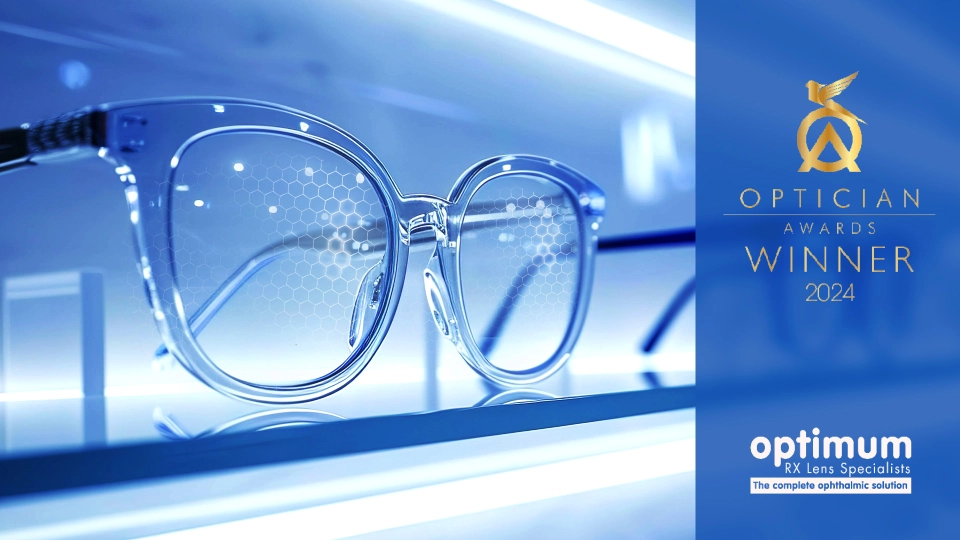
Guide to Optical Lenses: The Science Behind How They Work
- Defining optical lenses
- Understanding how optical lenses work
- Refraction
- Focal point and focal length
- Optical lens forms and types
- Optical lens forms
- Positive and negative meniscus lenses
- Optical meniscus lens types
- 1. Spherical Lenses
- 2. Astigmatic Lenses
- 3. Aspheric Lenses
- 4. Spherocylindrical Lenses
- 5. Spherotoric Lenses
- 6. Atoric Lenses
- 7. Freeform Lenses
- Optical lens designs
- How to achieve optimal visual clarity with innovative lens technologies
- Minimize oblique aberrations
- Control of mean power
- Binocular balance improvement
- Increase visual correction through lens surface design
- Pioneering custom optical lens technology

Guide to Optical Lenses: The Science Behind How They Work
In its simplest form, an optical lens focuses or disperses beams of light through refraction. The oldest optical lens discovered, the Nimrud lens, dates back to eighth-century Assyria. The Assyrians crafted this ancient lens from rock crystal with similarities to modern lenses. The discovery of the Nimrud lens as an early precursor to contemporary eyewear reveals the advanced technology of the Assyrians and the longstanding human endeavor to manipulate light and enhance vision through optical lenses. Fortunately for today's wearers, advancements in optical science have significantly broadened the scope and efficacy of lenses.
Defining optical lenses
An optical lens is crafted from transparent materials such as glass or plastic and is designed to manipulate light through refraction. These lenses bend light to bring images into focus, produce magnification, enhance projection, and correct optical aberrations. While cameras and telescopes also use optical lenses, they primarily serve as the foundation for vision-correcting glasses.
Eyeglass lenses are classified as transmissive optical devices because they allow light to pass through. They come in various shapes with unique designs custom-layered onto each to allow precise light manipulation and magnification and to meet a wearer’s needs.
Understanding how optical lenses work
Refraction
As light moves through a lens, it refracts or bends. Refraction allows the lens to either converge (focus) or diverge (diffuse) the light rays passing through it. The degree to which the light bends is determined by the lens's refractive index, which dictates how much the speed of light is reduced as it enters the lens material. This slowdown in speed is critical for manipulating light’s path, making it essential for designing optical lenses. Vision is corrected by focusing light precisely on the retina. Additionally, labs can manipulate how and where light converges or diverges by altering the shape and material of a lens.
Refraction drives optical lens technology, but it also collaborates with other factors, like shape and focal length, to manipulate light and images when a wearer looks through the lens.
Focal point and focal length

The focal point is a specific spot along the optical axis where light rays converge after passing through the lens. This spot is crucial because it is where objects come into focus. The distance from the center of the lens to the focal point is known as the “focal length.” Lenses with a short focal length bend and focus light more sharply, giving them greater optical power. This makes them ideal for applications like reading glasses that require magnifying close objects but less suitable for applications that require significant magnification, like intense corrective lenses. Conversely, lenses with longer focal lengths bend light more gently and have lower optical power, making them better suited for observing distant objects, like when piloting planes or viewing faraway horizons in landscape photography.
Optical lens forms and types
Though lens shape and lens type are closely related, they have distinct characteristics and impact the lens’s function differently.
Optical lens forms
The form of a lens refers to the physical curvature of the lens surfaces. The form and material of a lens significantly influence how it refracts light. Lenses can be convex, concave, or a combination of both, each form bending light differently. Convex lenses cause light rays to converge, focusing the light, while concave lenses cause light to diverge, spreading it out. The choice of material affects how much light slows down and must be considered when designing lenses to achieve the desired optical properties.
Lenses fall into one of the following general categories:
- Convex: A surface curves outward
- Concave: A surface curves inward
- Plano: One surface remains flat and can be combined with a curve on its other side
- Meniscus: Both surfaces are curved, but one is curved more significantly.
Within these categories, lens shapes combine in ways that affect light refraction, prompting various changes in vision. The optical industry mainly uses a meniscus lens, while other subcategories are found in equipment ranging from projectors to telescopes.

Positive and negative meniscus lenses
With a meniscus lens, both sides of the lens have a curve, but the curves bend opposite each other. One side will bend outwards, and the other will bend inwards (as opposed to biconvex, where both sides bow out, and biconcave lenses, where both sides bend inward). When looking at the lens, a positive meniscus lens is thicker in the center and thinner at the edges. A negative lens is the opposite and thinner in the center of the lens while thicker at the surrounding edge. The difference comes from addressing varying spherical aberrations.
Optical meniscus lens types
Lenses can also be classified according to their form and structure. Frequently used lens forms in ophthalmics consist of:
1. Spherical Lenses
These are the simplest form and most commonly used, with two spherical surfaces. Spherical lenses have rotational symmetry around the imaginary line that joins the center of each surface.
2. Astigmatic Lenses
Astigmatic forms are lenses with at least one astigmatic surface—a surface that does not have a uniform curvature—and therefore lack rotational symmetry.
3. Aspheric Lenses
This is a generic term which technically encompasses all lenses that are not spherical, like progressives and free form lenses. Aspherical lenses are manufactured from spherical semi-finished blanks with one aspherical surface, usually in the form of a conicoid.
4. Spherocylindrical Lenses
These are lenses that consist of a spherical and cylindrical surface. Spherocylindrical lenses were the first lens form used to correct ocular astigmatism.
5. Spherotoric Lenses
Spherotoric lenses consist of a front surface sphere and back surface torus and are the modern solution to correct ocular astigmatism.
6. Atoric Lenses
These lenses have a spherical front surface and an atoric back surface (varying curvatures across the lens) and are also designed to correct ocular astigmatism.
7. Freeform Lenses
Defined in ISO:18476:2017, a free form lens is a lens in which at least one free form surface is produced using free-form technology. This does not include conventional casting/molded front surface progressive-power surfaces.
As individuals can have unique visual requirements, lens forms sometimes combine elements from different meniscus lens types to provide proper visual corrections.
Optical lens designs
Optical lens manufacturers can create custom lenses that fix nuanced and specific visual issues by blending various technologies, shapes, functions, and forms. The most common types of lens designs for vision issues are:
- Monofocal lens: These correct for one field of vision, tackling either nearsightedness or farsightedness and addressing problems at one designated focal point. These are also known as single-vision lenses.
- Multifocal lenses: These lenses have multiple powers, so they adjust vision at varying focal points. Different types of multifocal lenses provide options for incorporating multiple powers in various techniques. This lens type includes progressive lenses, bifocals, trifocals, and custom designs for sports and certain professions.
Lens design experts incorporate additional technologies to address specific visual needs.
How to achieve optimal visual clarity with innovative lens technologies
Commitment to innovation and customization in optical lens technology goes a long way. Tailoring lens designs specifically to the nuanced requirements of a wearer can result in lenses that exceed expectations in performance and quality. Achieving optimal visual clarity involves technologies that achieve the following results:
Minimize oblique aberrations
Away from the center of the lens, oblique aberrations can reduce optical quality. Minimizing this impact can significantly enhance wearer satisfaction and comfort. Technologies, like IOT’s Digital Ray Path 2, minimize peripheral blur common to lenses such as progressive lenses by incorporating a wearer’s accommodative capacity, creating a high-definition visual experience for wearers.
Control of mean power
Thanks to our Steady Methodology, the swim effect found in progressive lenses is reduced by controlling for unwanted cylinder power and changes to mean power in the periphery. The additional technology added to the lens design significantly reduces blurring around the edge.
Binocular balance improvement
Combining control of mean power distribution and optimization for binocular performance is achieved with Steady Plus Methodology. This results in the eyes perceiving symmetrical powers for each gaze direction.
Increase visual correction through lens surface design
Combining complex curvatures on both lens surfaces results in variable base curves and flatter lenses. Camber technology provides labs with advanced custom lens curves bespoke to a patient’s visual needs. The technology provides an optimal visual experience for even the most complex presbyopic prescriptions.
Pioneering custom optical lens technology
The science behind optical lenses determines how well they function. The design and technology they incorporate impact all aspects, from light refraction to visual focus to oblique aberrations.
IOT integrates sophisticated methodologies into each lens to cater to a broad spectrum of visual needs, ensuring function and comfort in every lens design.
To learn more about the science and technology driving the forefront of the optical industry, get in touch and see which IOT lens designs are right for your customers.
To learn more about the science and technology at the forefront of the optical industry, fill out the form below.
You might also like:






